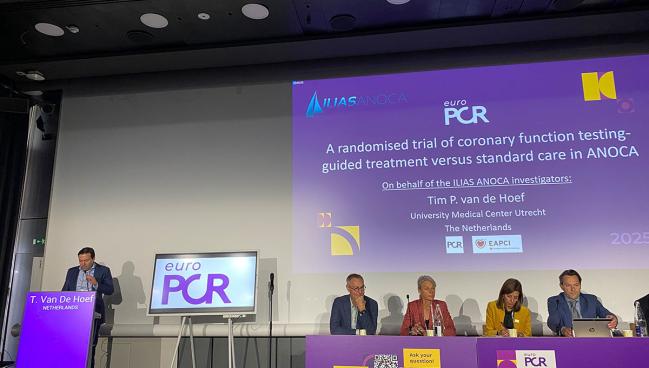Early Coronary Function Testing Improves Quality of Life in ANOCA
In the ILIAS ANOCA trial, using CFT to guide treatment according to ANOCA endotype led to larger QoL gains over 6 months.

PARIS, France—Coronary function testing (CFT) done during the index angiography in patients who have angina with no obstructive coronary artery disease (ANOCA) is not only feasible and safe but also can improve disease-related quality of life over time compared with standard care, according to data from the ILIAS ANOCA trial.
Coronary vasomotor dysfunction was found by CFT in 78% of 153 ANOCA patients, and there was a significant increase in Seattle Angina Questionnaire Summary Score (SAQSS) over 6 months in those who underwent early CFT rather than standard care.
The new study “strengthens the evidence supporting early coronary function testing to improve quality of life in these underserved patients with ANOCA,” said Tim van de Hoef (University Medical Center Utrecht, the Netherlands), who presented the findings at EuroPCR. CFT, which is very feasible and available in most cath labs, increases patients’ satisfaction by enabling them to receive an immediate diagnosis, he told TCTMD.
The pragmatic approach taken in this study—namely, that patients did not have to stop any medical therapy—showed that this protocol can be used in clinical practice, said van de Hoef. Referring physicians would receive the CFT diagnosis as well as a stepwise medical therapy guide that they could use to titrate medications.
Future studies will look to determine how physicians making decisions based on this information might change outcomes, he said.
European guidelines currently recommend invasive coronary angiography with functional testing to confirm or rule out obstructive coronary disease or ANOCA in patients with an uncertain diagnosis on noninvasive imaging (class I, level of evidence B). Functional testing is also recommended to define ANOCA and to identify potentially treatable endotypes (class I, level of evidence B).
US guidelines consider invasive functional testing reasonable to improve the diagnosis of patients with persistent chest pain without coronary obstruction (class 2a, level of evidence B).
Prior research has shown that CFT can be safely performed at centers regardless of experience, but it is often only offered to patients as a secondary procedure in those who remain symptomatic, said van de Hoef.
The ILIAS ANOCA Trial
For the ILIAS ANOCA trial, researchers enrolled 153 patients (mean age 63 years; 54.9% female) with ANOCA who were referred for invasive coronary angiography. All underwent CFT, including coronary flow reserve, microvascular resistance, and acetylcholine provocation, a process embedded within the care pathway with no interruption in medical therapy. They were randomized to undergo standard care (n = 76), where physicians were blinded to the CFT findings, or receive CFT-guided treatment (n = 77).
Patients with obstructive CAD were excluded. Mean SAQSS at baseline was 65 in the control arm and 58 in the intervention group.
CFT picked up coronary vasomotor dysfunction in four out of every five patients: isolated coronary spasm in 42%, mixed spasm and coronary microvascular dysfunction (CMD) in 20%, functional angina in 8%, and isolated CMD in 7%.
Over 6 months, those randomized to the intervention reported a 9.4-point higher change in SAQSS than those who received standard care (P = 0.001). This was driven by significantly greater improvements in quality of life and angina frequency (P = 0.001 for both) as well as a numerically larger improvement in physical limitation.
All CFT procedures were performed successfully in an average of 21 minutes, including about 10 minutes of waiting time. There were no adverse procedural events and no major adverse cardiac events over follow-up.
Asked about what can be taken away from the study in contrast to WARRIOR, which did not show that intensive medical therapy improves outcomes in women who had ischemia with nonobstructive coronary arteries, van de Hoef said the new data are strengthened by a key difference.
In WARRIOR, “we did not know whether they had spasm or coronary microvascular dysfunction and they were all treated with the exact same therapy,” he said. “I think this shows the additional impact of endotyping the patients and targeting the medication to the individual endotype. So whether they have spasm or coronary microvascular dysfunction or a mix, that’s actually the aspect that improves the quality of life, not putting all these patients on the exact same medical therapy. We need to individualize the medical therapy to improve their conditions.”
Yael L. Maxwell is Senior Medical Journalist for TCTMD and Section Editor of TCTMD's Fellows Forum. She served as the inaugural…
Read Full BioSources
van de Hoef TP. A randomised trial of coronary function testing-guided treatment versus standard care in ANOCA. Presented at: EuroPCR 2025. May 22, 2025. Paris, France.
Disclosures
- ILIAS ANOCA was funded through a restricted institutional grant from Philips.
- van de Hoef reports receiving research grants from Philips, Abbott, Shockwave Medical, and Vahaticor.





Comments